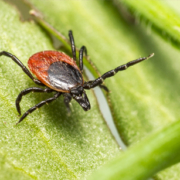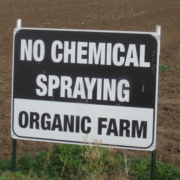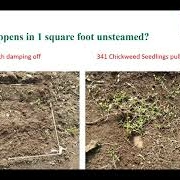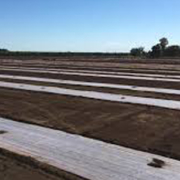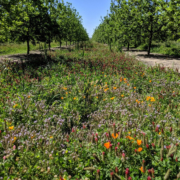Insect Netting for Spray-Free Insect Control on Small Farms
 Print This Post
Print This Post
By Dan Birnstihl, NCAT Sustainable Agriculture Specialist
As I walked through the high tunnels in mid-July 2020, a frustration set in that it may not be possible to grow greenhouse cucumbers without spraying them. In my previous role as Farm Director at Hip Peas Farm, a peri-urban microfarm in Hooksett, New Hampshire, we had a demand for greenhouse cucumbers. These pests presented a huge problem for us, as we were attempting to be a completely spray-free operation. Each year, a mix of striped-cucumber beetles and squash bugs would come in once the plants were trellised at about 3 feet tall, and by the time they reached 6 feet tall, the plants would start to succumb to injury and bacterial wilt, spread by the cucumber beetles. This meant that up to three times a year we were planting new cucumber plants in different locations that never reached full production, playing a constant cat-and-mouse game with the pests.

Dan Birnstihl and the crew at Hip Peas Farm standing in the doorway of their insect exclusion high-tunnel. Photo: Dan Birnstihl, NCAT
This year, we had one last plan to make this work: we would cover the entire 30’ x 52’ high tunnel in insect netting, and plant only parthenocarpic varieties, meaning that they will bear fruit without the need for pollination. The process was surprisingly simple and cost-efficient. One roll of 70-gram netting measuring 6.9’ x 328’ was more than enough to cover the entire 52-foot tunnel, as well as an additional 30’ X 96’ tunnel, and was being sold at our local farm supply store for under $450.
That may give you sticker shock, but the results of this practice increased our cucumber sales from under $500 in July 2020, struggling to keep up with demand, to almost $2,000 in 2021. That means for a third of the price of that roll, we saw an increase in sales of almost $1,500 in one month with very little labor involved. Those results repeated in August, with an additional $1,000 in sales in 2021 compared to 2020.
It wasn’t a perfect solution, as we made two crucial mistakes in implementing this strategy that could have been easily avoidable. First, as previously mentioned, we struggled in 2020 to keep up with demand, so when we did our crop planning in 2021, we approached cucumbers as if our yields would be similar, but steadier, throughout the year. This was categorically wrong. We planted the same amount of cucumbers in 2021 as we did the year prior, but we didn’t anticipate how much heavier the yields of cucumber trellised cucumbers would be once the plants got taller than 6 feet. In June, our biggest problem was no longer meeting demand, but instead how to move the excess cucumber that we were growing. Our plan, therefore, was to halve the amount of cucumber we grew in 2022 and replace the other half of the tunnel with melons. As a small farmer, this was perfect, as it meant we could add another high-value crop into the mix with a similar growth strategy.
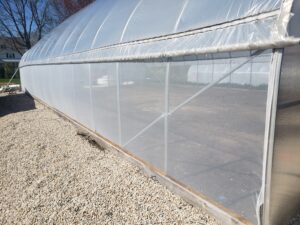
Insect netting applied underneath the high tunnel polyethylene makes use of the roll-up sides possible. Photo: Dan Birnstihl, NCAT
The second mistake we made was that we purchased one roll of insect netting to pull double duty. We not only wanted to create an insect exclusion area inside the high tunnel, but also to create insect-excluded low tunnels for some of our field crops – a matter to which we will return. This caused us to purchase one large roll of 25-gram netting, thinking we could also use the netting on the tunnel to exclude aphids and thrips. The result was stagnant air flow inside the high tunnel, which led to unbearably hot temperatures. This made working inside the tunnel in the afternoons nearly impossible. It also increased humidity, which in turn led to an increase in downy mildew in the late season. While the increased cucumber sales more than made up for the potential crop loss from downy mildew, this is a problem that could potentially be solved by selecting a more appropriate netting weight, such as the 70-gram mentioned earlier.
While the cost of the netting justified itself for cucumbers alone, it also made growing new crops, and increasing the yield of others, possible. One crop that was new in 2021 was hakurei, or Tokyo turnips. These small, white, salad turnips were a huge hit in our markets, but we couldn’t grow them without cabbage root maggots boring holes inside the otherwise pristine white roots and ruining the beautiful veggies. Once we started covering them with insect netting low tunnels, we were able to grow them reliably. This practice alone led to an additional $500 a month in sales. We also used the same technique to increase the marketable yield of our leafy greens such as arugula, baby kale, and tatsoi by protecting them from flea beetle damage.
Of course, insect netting isn’t a panacea. Any gaps in your netting can allow insects to bypass the exclusion barrier, there is more labor in setting up and tearing down the low tunnels, and there is a big problem with increased temperatures inside the low tunnels. This can be a huge help the spring and fall, but it can also lead to crop loss in the summer months. As mentioned earlier, sizing your netting to only exclude the pests you’re targeting can help to mitigate this problem, as opposed to a one-size-fits-all approach.
Labor wasn’t as much of an issue for our high tunnel application, as we set up our netting on the tunnel to be a permanent fixture, being attached underneath the polyethylene wiggle-wire channels, and affixing it to the baseboard using cut field stakes and a nail gun. We also created wooden screens to screw into the fans and vents, creating a truly insect-free tunnel. This one-time labor cost is easily offset by the labor that would be needed to spray inside the tunnels, potentially multiple times each week over the course of one year. It also eliminates the need to set up “no-entry” zones where employees or guests are not allowed inside the tunnel following a spray event, reduces pesticide use, and increases marketability in farmers markets.
For us, Integrated Pest Management, or IPM, was all about identifying areas where insects can be controlled using the path of least resistance. If that meant trying to plant in a different area, or playing with planting times to avoid a pest, we would always see if it could give our crops a better chance at success. We found insect netting to be a great addition to our farm’s IPM toolbox due to its low cost, easy implementation, and high efficacy. You can learn more about insect netting applications in the resources listed below.
Related ATTRA Resources:
Biorationals: Ecological Pest Management Database
IPM for Greenhouse Crops
Other Resources:
How can I manage pests while minimizing harmful effects on my health and the environment? University of New Hampshire.
Installing High Tunnel Insect Exclusion Screen. Purdue Extension Entomology.
Insect Netting for Pest Protection. Bootstrap Farmer.
This blog is produced by the National Center for Appropriate Technology through the ATTRA Sustainable Agriculture program, under a cooperative agreement with USDA Rural Development. ATTRA.NCAT.ORG.


